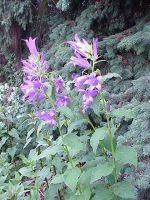 Great bellflower is a coarse, clump-forming herbaceous perennial and a member of the Campanulaceae family that also includes balloon flower, lady bells (Adenophora), and Lobelia. It is native to Europe and eastern Asia to Kashmir where it grows in woodlands and forest margins. Plants grow 3-4′ tall and have hairy unbranched stems with toothed, ovate leaves up to 6″ long . The leaves have long petioles at the base of the stem but become smaller, narrower, and sessile as they ascend. Short terminal racemes of purplish-blue bell-shaped flowers up to 2.5″ long appear in the upper leaf axils in early summer. Great bellflower does not tolerate heat and may need staking so is best used in a cool region in an informal setting such as a cottage or woodland garden. The genus name, Campanula, comes from the Late Latin word, campana, meaning bell and refers to the form of the flowers. The specific epithet, latifolia, comes from the Latin words latus meaning wide, and flora, meaning leaf, and refers to the width of the leaves.
Great bellflower is a coarse, clump-forming herbaceous perennial and a member of the Campanulaceae family that also includes balloon flower, lady bells (Adenophora), and Lobelia. It is native to Europe and eastern Asia to Kashmir where it grows in woodlands and forest margins. Plants grow 3-4′ tall and have hairy unbranched stems with toothed, ovate leaves up to 6″ long . The leaves have long petioles at the base of the stem but become smaller, narrower, and sessile as they ascend. Short terminal racemes of purplish-blue bell-shaped flowers up to 2.5″ long appear in the upper leaf axils in early summer. Great bellflower does not tolerate heat and may need staking so is best used in a cool region in an informal setting such as a cottage or woodland garden. The genus name, Campanula, comes from the Late Latin word, campana, meaning bell and refers to the form of the flowers. The specific epithet, latifolia, comes from the Latin words latus meaning wide, and flora, meaning leaf, and refers to the width of the leaves.
Type: Herbaceous perennial
Bloom: Short terminal racemes of purplish-blue bell-shaped flowers up to 2.5″ long in early summer
Size: 3-4′ H x 3′ W
Light:Full sun to part shade (needs some shade in hot climates)
Soil:Average, medium moist, well-drained
Hardiness: Zones 3-7
Care: Cut back after flowering to restrict self seeding; divide every 3-4 years
Pests and Diseases: None of significance
Propagation: Seed, division in early spring
Companion Plants: Love in the midst, small yellow foxglove, cluster head pink
Outstanding Selections:
var. alba (white flowers)
‘Brantwood’ (violet flowers)
‘Gloaming’ (pale blue flowers)
Photo Credit: Franz Xaver, Wikimedia Commons